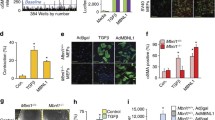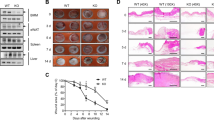Abstract
During the wound-healing process, macrophages, fibroblasts, and myofibroblasts play a leading role in shifting from the inflammation phase to the proliferation phase, although little is known about the cell differentiation and molecular control mechanisms underlying these processes. Previously, we reported that Tsukushi (TSK), a member of the small leucine-rich repeat proteoglycan family, functions as a key extracellular coordinator of multiple signalling networks. In this study, we investigated the contribution of TSK to wound healing. Analysis of wound tissue in heterozygous TSK-lacZ knock-in mice revealed a pattern of sequential TSK expression from macrophages to myofibroblasts. Quantitative PCR and in vitro cell induction experiments showed that TSK controls macrophage function and myofibroblast differentiation by inhibiting TGF-β1 secreted from macrophages. Our results suggest TSK facilitates wound healing by maintaining inflammatory cell quiescence.



Similar content being viewed by others
References
Blanpain C, Fuchs E (2006) Epidermal stem cells of the skin. Annu Rev Cell Dev Biol 22:339–373
Brancato SK, Albina JE (2011) Wound macrophages as key regulators of repair: origin, phenotype, and function. Am J Pathol 178:19–25
Chen H, Yang WW, Wen QT, Xu L, Chen M (2009) TGF-beta induces fibroblast activation protein expression; fibroblast activation protein expression increases the proliferation, adhesion, and migration of HO-8910 PM. Exp Mol Pathol 87:189–194
Comalada M, Cardó M, Xaus J, Valledor AF, Lloberas J, Ventura F, Celada A (2003) Decorin reverses the repressive effect of autocrine-produced TGF-beta on mouse macrophage activation. J Immunol 170:4450–4456
Cotsarelis G (2006) Epithelial stem cells: a folliculocentric view. J Investig Dermatol 126:1459–1468
Eming SA, Krieg T, Davidson JM (2007) Inflammation in wound repair: molecular and cellular mechanisms. J Investig Dermatol 127:514–25
Gurtner GC, Werner S, Barrandon Y, Longaker MT (2008) Wound repair and regeneration. Nature 453:314–321
Hinz B (2007) Formation and function of the myofibroblast during tissue repair. J Investig Dermatol 127:526–537
Ito A, Shinmyo Y, Abe T, Oshima N, Tanaka H, Ohta K (2010) Tsukushi is required for anterior commissure formation in mouse brain. Biochem Biophys Res Commun 402:813–818
Niimori D, Kawano R, Felemban A, Niimori-Kita K, Tanaka H, Ihn H, Ohta K (2012) Tsukushi controls the hair cycle by regulating TGF-β1 signaling. Dev Biol 372:81–87
Ohta K, Lupo G, Kuriyama S, Keynes R, Holt CE, Harris WA, Tanaka H, Ohnuma S (2004) Tsukushi functions as an organizer inducer by inhibition of BMP activity in cooperation with chordin. Dev Cell 7:347–358
Ohta K, Ito A, Kuriyama S, Lupo G, Kosaka M, Ohnuma S, Nakagawa S, Tanaka H (2011) Tsukushi functions as a Wnt signaling inhibitor by competing with Wnt2b for binding to transmembrane protein Frizzled4. Proc Natl Acad Sci U S A 108:14962–14967
Oshima H, Rochat A, Kedzia C, Kobayashi K, Barrandon Y (2001) Morphogenesis and renewal of hair follicles from adult multipotent stem cells. Cell 104:233–245
Schaefer L, Iozzo RV (2008) Biological functions of the small leucine-rich proteoglycans: from genetics to signal transduction. J Biol Chem 283:21305–21309
Acknowledgments
We thank Prof. Tanaka for his valuable comments, Mrs. Iimori for her technical assistance, and all members of our lab for their valuable help. This study was supported by KAKENHI Grant Numbers 21659268 & 25860957 and the Kumamoto University Global COE Program (Cell Fate Regulation Research and Education Unit).
Conflict of interest
The authors have no conflict of interest to declare.
Author information
Authors and Affiliations
Corresponding author
Rights and permissions
About this article
Cite this article
Niimori, D., Kawano, R., Niimori-Kita, K. et al. Tsukushi is involved in the wound healing by regulating the expression of cytokines and growth factors. J. Cell Commun. Signal. 8, 173–177 (2014). https://doi.org/10.1007/s12079-014-0241-y
Received:
Accepted:
Published:
Issue Date:
DOI: https://doi.org/10.1007/s12079-014-0241-y




